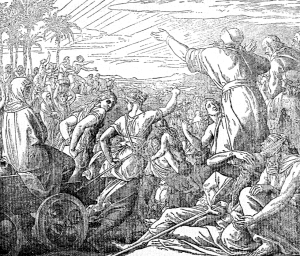 The Jews were in captivity for seventy years. But when Cyrus, king of Persia, became king of Babylon, he issued a proclamation allowing the Jews to return to their native country.
The Jews were in captivity for seventy years. But when Cyrus, king of Persia, became king of Babylon, he issued a proclamation allowing the Jews to return to their native country. The Jews were in captivity for seventy years. But when Cyrus, king of Persia, became king of Babylon, he issued a proclamation allowing the Jews to return to their native country.
The Jews were in captivity for seventy years. But when Cyrus, king of Persia, became king of Babylon, he issued a proclamation allowing the Jews to return to their native country.
Zorobabel, a prince among the Jews, led more than 40,000 of his people back to Jerusalem. Cyrus restored to them the golden and silver vessels which Nabuchodonosor had taken from the Temple.
At their arrival in Jerusalem, the Jews set up a temporary altar, and renewed the Mosaic ritual of prayer and sacrifice. They then started rebuilding the Temple on the site on which Solomon's Temple had stood.
After about twenty years, the new temple was completed, and dedicated amidst much rejoicing. But the old men, who had seen Solomon's Temple, lamented because the new one was much less magnificent.
However, the prophet Aggeus consoled the Jews, saying that the glory of the second Temple would be greater than that of the first, because the Messias Himself would enter it. This prophecy was fulfilled, for Jesus later taught in this Temple.
Twenty years after Zorobabel's return to Jerusalem, Esdras, a holy priest, gathered together many Jews still remaining in Babylon, and led them back to Judea. With the aid of his friend Nehemias, he instructed the people in the law of God.
Nehemias urged the building of the wall of Jerusalem. In two nonths the city was surrounded by strong walls as a protection against enemies.
In the days of Nehemias, Malachias, the last of the prophets, lived, about 400 years before Christ. Malachias preached against the hypocrites of his day. He predicted that God would reject the sacrifices of the Old Law, and in their place would institute a New Sacrifice that would not cease, "from the rising of the sun even to the going down." This prophecy is fulfilled in the Sacrifice of the Mass.
At the destruction of Solomon's Temple, the prophet Jeremias had hidden the Ark of the Covenant. In later years it could not be found. So in the new Temple, the Jews marked the place for the Ark with a stone, and performed certain ceremonies over it.
In this way did God remove the most sacred vessel of the Old Law. to prepare for the coming of Christ. For the Ark of the Covenant was only a figure of the Tabernacle containing the Real Presence of the Son of God.
- from My Bible History in Pictures, by Bishop Louis LaRavoire Morrow, D.D., 1934; it has the Imprimatur of Archbishop Michael J O'Doherty of Manila, Philippines